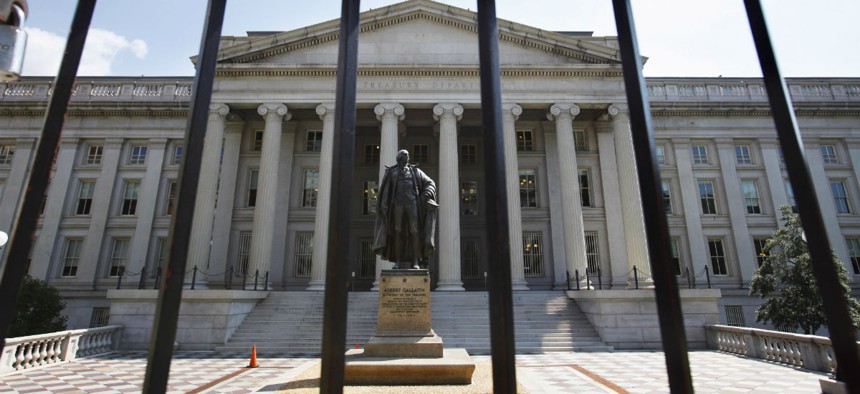Treasury Needs $110M Piggy Bank to Combat IRS Hackers and Other Expected 'Cyberattacks'

This Monday, Aug. 8, 2011, file photo, shows the Treasury Building in Washington. AP Photo/Jacquelyn Martin, File
A White House-ordered search for “high-value” targets attractive to hackers emphasized the need for a cyber-emergency piggy bank, according to budget documents.
The Treasury Department says it needs a central cashbox to draw from for security fixes that could lessen the blow of anticipated hack attacks against the Internal Revenue Service, banks and other systems handling trillions of dollars.
A White House-ordered search for “high-value” data holdings attractive to hackers emphasized the need for a cyber-emergency piggy bank, according to budget documents. Since October, all departments have been hurrying to hide the silverware in hopes of avoiding a repeat of last year’s big breach, in which 21.5 million records on national security personnel and their families were filched from the Office of Personnel Management.
Treasury underpins the world economy, "with trillions of dollars flowing through its information systems—several of which the administration's Cybersecurity Strategy and Implementation Plan identified as high-value assets," the department's 2017 budget appendix states. "As a result, Treasury is a constant target for sophisticated threat actors."
To guard against the bad guys in "a proactive" way, Treasury expects to create the so-called Cybersecurity Enhancement Account, department officials said.
The cashbox will be used to “more strategically focus Treasury’s cybersecurity efforts and avoid fragmentation of IT management across bureaus that leads to cost inefficiencies and limits Treasury’s ability to nimbly respond in the event of a cyberattack,” according to a Treasury budget fact sheet.
For example, IRS and the U.S. Digital Service, a corps of White House coding gurus, are teaming to tighten login controls on every IRS online service, Treasury officials said.
In 2017, the effort will be spun off into a new Treasury “Digital Infrastructure Security Team” that will improve existing safeguards on all internal applications and public websites, they added.
The central account, furnished with a proposed $110 million, would support specific initiatives at agencies, along with cross-cutting, departmental activities and partnerships with the financial services sector, officials said. The IRS would bankroll most of the fund ($62 million), while departmentwide financing would cover the rest.
Some spending, for instance, would go toward investments "for critical improvements to the Treasury Secure Data Network," a classified system that shares intelligence with other law enforcement agencies, officials said.
At the IRS, the money would help stem ongoing security issues there, with investments to “protect and safeguard sensitive taxpayer information, and improve fraud detection and prevention."
This year, the IRS is facing a doozy of a scam season. On Friday, the agency announced a 400 percent bounce in email phishing and malware attacks designed to defraud taxpayers. As of mid-February, the IRS has already suffered 1,389 incidents, beyond halfway toward surpassing last year’s total of 2,748 incidents.
The IRS has not been able to overhaul a faulty login system on its "Get Transcript" webpage that last year allowed ID thieves to see 334,000 taxpayers' records. The tax agency reported it had spent $2.7 million on the tool, which displays a taxpayer's prior year returns.
Last filing season, fraudsters used the cribbed data to illegally collect refunds totaling about $39 million and are likely to try claiming more money this year, IRS officials have said. The electronic-viewing system was taken offline last May.
Another online form, which fraud victims fill out to receive an identity protection PIN, relies on the same flawed access mechanism. The shortcoming of Get Transcript and the ID protection PIN is their reliance on the taxpayer supplying static personal information, which impostors can learn from searching social networks or consulting the online black market.
Earlier this month, IRS officials disclosed that crooks faked out yet another IRS system with an automated “bot." The malicious software program entered stolen Social Security numbers – again, obtained elsewhere – to retrieve e-file PINs for claiming tax refunds.
The malware successfully grabbed 101,000 PINs in January. Agency officials said they have stopped the bogus usage of the system.






